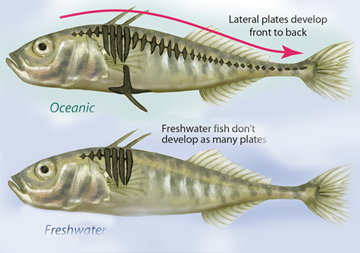These are what the chromosomes of a human look like. Chromosome pairs like these are in every human cell. The last pair determines the gender of the person.
Courtesy of the National Library of Medicine and NIH
Chromosomes, DNA and Genes: Tiny Things That Have a Huge Effect on Who We Are!
Do you look a bit like your brothers or sisters?
Do you look a bit like your parents?
You may look alike because, unless you were adopted, you and the other members of your family have genes in common.
Genes are the instructions that tell your body how is should be built and what it can do. An organism has the same genes for its entire life.
Where are those genes? They are very tiny! Genes are located in the center of each cell in tiny but complex molecules called chromosomes. There are many genes within each chromosome. The chromosome molecules contain all sorts of information about what makes you special and different from everyone else. All living things that have eukaryotic cells, such as dogs, butterflies, and fish, have chromosomes in their cells. Chromosomes come in pairs. In your body, one chromosome of each pair came from your mother and one came from your father.
For each gene there can be many varieties. In your body, there are two varieties of the same gene. One came from your mother and the other came from your father. The two varieties do not always contain the same instructions. For instance, one variety might tell the body that eyes should be blue while another variety tells that eyes should be brown. The dominant gene determines the actual color of the person's eyes.
You might also be interested in:

Scientists have been studying stickleback fish to learn more about how animals cope with changes in their environment. Some stickleback fish live in the ocean while others live in freshwater. That’s a
...more
Jupiter's atmospheric environment is one of powerful winds, going 250 miles per hour, and temperatures from -270 degrees to +32 degrees (freezing temperature). These winds make it hard for life forms to
...more
In July, 1996 a team of scientists said that they had discovered possible fossils of bacteria in a meteorite named ALH84001 that came from Mars. It was found in Antarctica in 1984 after having landed there
...more
Saturn's atmospheric environment is one of powerful winds, going 250 miles per hour, and temperatures from -270 degrees to +80 degrees. With winds like these, it is hard to have peace and quiet. The region
...more
The air of Titan is a lot like the Earth's, except that it is very cold, from -330 degrees to -290 degrees! Like the Earth, there is a lot of Nitrogen and other complex molecules. There also may be an
...more
Organisms that are able to "make their own food" are called autotrophs, meaning "self-feeders". Some examples of autotrophs are plants and algae (shown in the picture). Both plants and algae use photosynthesis
...more
In the warm early ocean, large molecules came together into a form called *coacervates*. Molecules such as these will form coacervates in the same way that beads of vinegar in oil come together. These
...more















